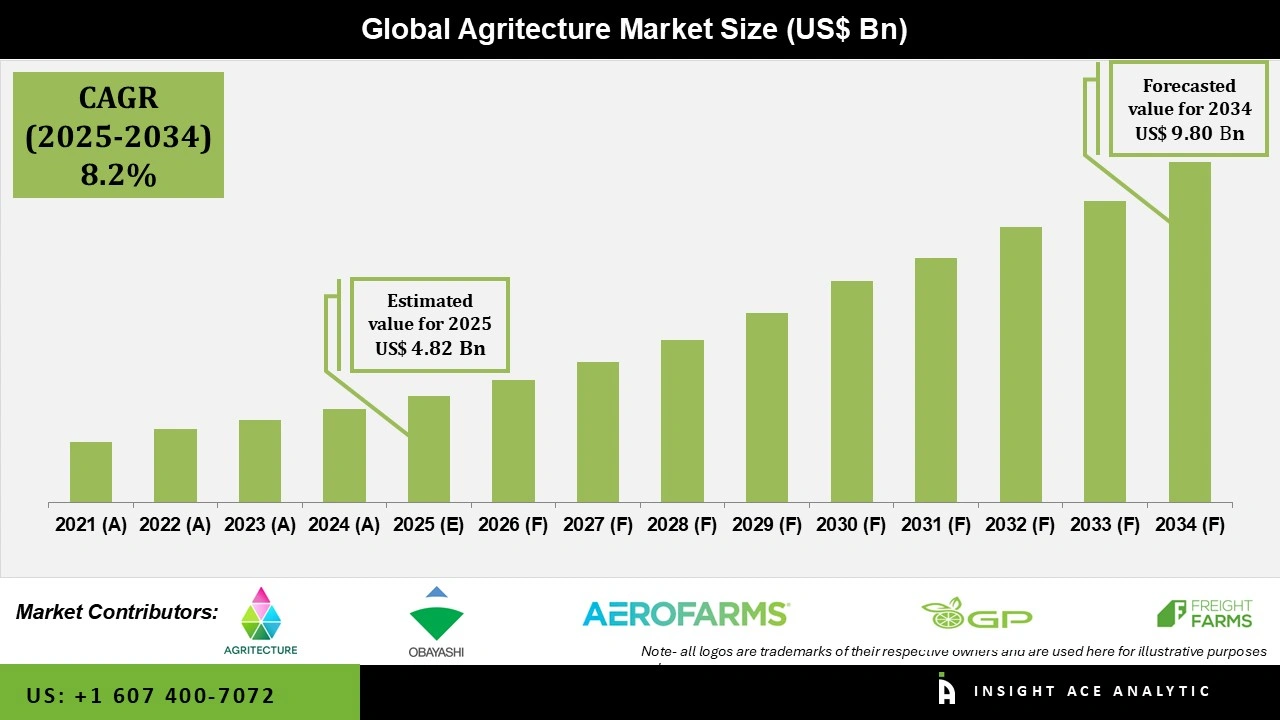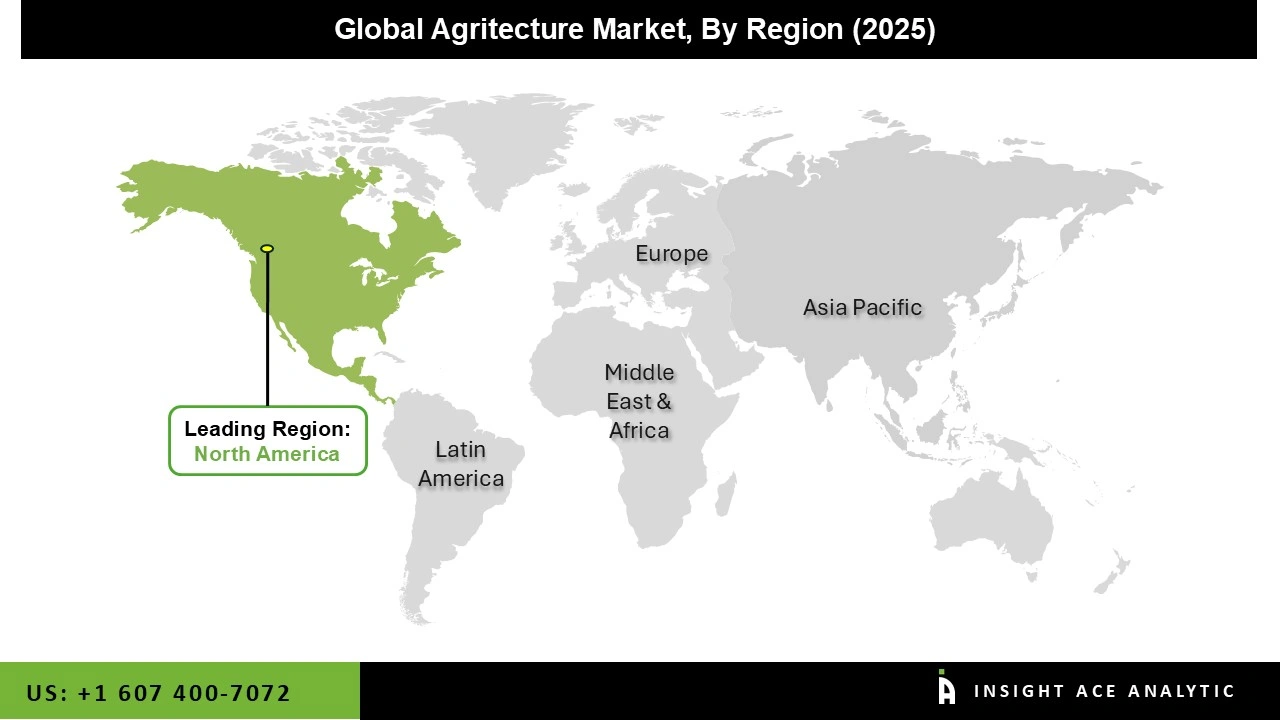Agritecture Market Size is valued at US$ 4.8 Bn in 2025 and is predicted to reach US$ 9.8 Bn by the year 2034 at an 8.2% CAGR during the forecast period for 2025-2034.

Agritecture integrates agriculture with architecture to enable food production in urban spaces through vertical farms, rooftop greenhouses, and indoor systems. Using hydroponics, LED lighting, and climate control, it achieves 10–100x higher yields per square foot while cutting water use by 95%, eliminating pesticides, and reducing food miles by 90%. It transforms cities into sustainable food hubs, improving air quality and creating green jobs.
Rapid urbanization, shrinking farmland, and rising demand for local produce drive agritecture growth. With 68% of people living in cities by 2050 and 1.2% annual global food demand growth (OECD-FAO 2024-2033), space-efficient farming is essential. AI farm management, energy-efficient LEDs, and modular systems have improved economics, while cities like Singapore target 30% local production by 2030.
High capital costs ($100–$500/sq ft) and energy-intensive operations remain primary barriers, often requiring 20–40 kWh per kg of produce without renewable integration. Skilled labor shortages and market education also hinder widespread adoption. However, transformative opportunities are emerging: declining solar panel costs (down 89% since 2010) and battery storage make energy-neutral farms economically viable.
Digital supply chain platforms enable premium direct-to-consumer sales with 2–3x margins. Government incentives—tax credits, grants, and zoning reforms—are accelerating deployment in cities like Dubai and New York. As leading retailers (Walmart, Kroger) partner with vertical farm operators and real estate developers integrate agritecture as premium amenities, the sector is positioned for exponential growth, potentially reaching $20+ billion by 2030.
Some of the Key Players in Agritecture Market:
The agritecture market is segmented by integration, structure, and application. By integration, the market is segmented into indoor and outdoor. By integration, the market is segmented into retrofitting, extension, and new building. By application, the market is segmented into commercial and residential.
The Outdoor category led the Agritecture market in 2024. This convergence is fueled by due to their inherent reliance on sunshine and ventilation, outdoor systems are less expensive to install and maintain. Adoption is further accelerated by municipal regulations that support urban farming and green roofs. Because outdoor architecture increases building value, improves air quality, and offers obvious sustainability benefits that draw in both businesses and inhabitants, developers also appreciate it.
The largest and fastest-growing Application is Residential, a trend driven by growing urbanization is the main cause of this acceleration since it reduces traditional agricultural acreage and increases customer demand for fresh, locally sourced, and sustainably produced food. Residential adoption is also driven by the goal for increased environmental sustainability and food security, as integrated farming systems encourage resource efficiency and lessen the need for transportation.
North America dominated the Agritecture market in 2024. The United States is at the forefront of this expansion. This is due to theExtensive use of cutting-edge agricultural technologies and significant investments in R&D projects. Strong government incentives and legislation that favor innovative technology and sustainable farming methods further reinforce this dominance. The demand for regional food production is also fueled by growing urbanization, which promotes the growth of modular agricultural systems and vertical farming.

With rapid population expansion becoming more and more common in the Asia-Pacific area, the Agritecture market is expanding at the strongest and fastest rate in this region. Additionally, intense pressure to produce food locally brought on by dense cities, scarce farmland, and rapid population expansion support the market growth. To increase food security, nations like South Korea, Singapore, and Japan are making significant investments in smart building-integrated growing systems and vertical farms. Adoption is encouraged in the meanwhile by growing affluence and robust government support for sustainable urban development.
| Report Attribute | Specifications |
| Market Size Value In 2025 | USD 4.8 Bn |
| Revenue Forecast In 2034 | USD 9.8 Bn |
| Growth Rate CAGR | CAGR of 8.2% from 2025 to 2034 |
| Quantitative Units | Representation of revenue in US$ Bn and CAGR from 2025 to 2034 |
| Historic Year | 2021 to 2024 |
| Forecast Year | 2025-2034 |
| Report Coverage | The forecast of revenue, the position of the company, the competitive market structure, growth prospects, and trends |
| Segments Covered | By Integration, By Structure, By Application, and By Region |
| Regional Scope | North America; Europe; Asia Pacific; Latin America; Middle East & Africa |
| Country Scope | U.S.; Canada; Germany; The UK; France; Italy; Spain; Rest of Europe; China; Japan; India; South Korea; Southeast Asia; Rest of Asia Pacific; Brazil; Argentina; Mexico; Rest of Latin America; GCC Countries; South Africa; Rest of the Middle East and Africa |
| Competitive Landscape | Agritecture Consulting LLC, AeroFarms, LLC, Obyashi Corporation, Freight Farms, Inc., GP Solutions, Inc., LettUs Grow Ltd., FarmBox Foods, Crop One Holdings, Inc., BRIO Hydroponics, and Sky Greens |
| Customization Scope | Free customization report with the procurement of the report, Modifications to the regional and segment scope. Geographic competitive landscape. |
| Pricing and Available Payment Methods | Explore pricing alternatives that are customized to your particular study requirements. |
Chapter 1. Methodology and Scope
1.1. Research Methodology
1.2. Research Scope & Assumptions
Chapter 2. Executive Summary
Chapter 3. Global Agritecture Market Snapshot
Chapter 4. Global Agritecture Market Variables, Trends & Scope
4.1. Market Segmentation & Scope
4.2. Drivers
4.3. Challenges
4.4. Trends
4.5. Investment and Funding Analysis
4.6. Porter's Five Forces Analysis
4.7. Incremental Opportunity Analysis (US$ MN), 2025-2034
4.8. Global Agritecture Market Penetration & Growth Prospect Mapping (US$ Mn), 2024-2034
4.9. Competitive Landscape & Market Share Analysis, By Key Player (2024)
4.10. Use/impact of AI on AGRITECTURE MARKET Industry Trends
Chapter 5. Agritecture Market Segmentation 1: By Integration, Estimates & Trend Analysis
5.1. Market Share by Integration, 2024 & 2034
5.2. Market Size (Value US$ Mn) & Forecasts and Trend Analyses, 2021 to 2034 for the following Integration:
5.2.1. Indoor
5.2.2. Outdoor
Chapter 6. Agritecture Market Segmentation 2: By Structure, Estimates & Trend Analysis
6.1. Market Share by Structure, 2024 & 2034
6.2. Market Size (Value US$ Mn) & Forecasts and Trend Analyses, 2021 to 2034 for the following Structure:
6.2.1. Retrofitting
6.2.2. Extension
6.2.3. New Building
Chapter 7. Agritecture Market Segmentation 3: By Application, Estimates & Trend Analysis
7.1. Market Share by Application, 2024 & 2034
7.2. Market Size (Value US$ Mn) & Forecasts and Trend Analyses, 2021 to 2034 for the following Application:
7.2.1. Commercial
7.2.2. Residential
Chapter 8. Agritecture Market Segmentation 4: Regional Estimates & Trend Analysis
8.1. Global Agritecture Market, Regional Snapshot 2024 & 2034
8.2. North America
8.2.1. North America Agritecture Market Revenue (US$ Million) Estimates and Forecasts by Country, 2021-2034
8.2.1.1. US
8.2.1.2. Canada
8.2.2. North America Agritecture Market Revenue (US$ Million) Estimates and Forecasts by Integration, 2021-2034
8.2.3. North America Agritecture Market Revenue (US$ Million) Estimates and Forecasts by Structure, 2021-2034
8.2.4. North America Agritecture Market Revenue (US$ Million) Estimates and Forecasts by Application, 2021-2034
8.3. Europe
8.3.1. Europe Agritecture Market Revenue (US$ Million) Estimates and Forecasts by Country, 2021-2034
8.3.1.1. Germany
8.3.1.2. U.K.
8.3.1.3. France
8.3.1.4. Italy
8.3.1.5. Spain
8.3.1.6. Rest of Europe
8.3.2. Europe Agritecture Market Revenue (US$ Million) Estimates and Forecasts by Integration, 2021-2034
8.3.3. Europe Agritecture Market Revenue (US$ Million) Estimates and Forecasts by Structure, 2021-2034
8.3.4. Europe Agritecture Market Revenue (US$ Million) Estimates and Forecasts by Application, 2021-2034
8.4. Asia Pacific
8.4.1. Asia Pacific Agritecture Market Revenue (US$ Million) Estimates and Forecasts by Country, 2021-2034
8.4.1.1. India
8.4.1.2. China
8.4.1.3. Japan
8.4.1.4. Australia
8.4.1.5. South Korea
8.4.1.6. Hong Kong
8.4.1.7. Southeast Asia
8.4.1.8. Rest of Asia Pacific
8.4.2. Asia Pacific Agritecture Market Revenue (US$ Million) Estimates and Forecasts by Integration, 2021-2034
8.4.3. Asia Pacific Agritecture Market Revenue (US$ Million) Estimates and Forecasts by Structure, 2021-2034
8.4.4. Asia Pacific Agritecture Market Revenue (US$ Million) Estimates and Forecasts By Application, 2021-2034
8.5. Latin America
8.5.1. Latin America Agritecture Market Revenue (US$ Million) Estimates and Forecasts by Country, 2021-2034
8.5.1.1. Brazil
8.5.1.2. Mexico
8.5.1.3. Rest of Latin America
8.5.2. Latin America Agritecture Market Revenue (US$ Million) Estimates and Forecasts by Integration, 2021-2034
8.5.3. Latin America Agritecture Market Revenue (US$ Million) Estimates and Forecasts by Structure, 2021-2034
8.5.4. Latin America Agritecture Market Revenue (US$ Million) Estimates and Forecasts by Application, 2021-2034
8.6. Middle East & Africa
8.6.1. Middle East & Africa Agritecture Market Revenue (US$ Million) Estimates and Forecasts by country, 2021-2034
8.6.1.1. GCC Countries
8.6.1.2. Israel
8.6.1.3. South Africa
8.6.1.4. Rest of Middle East and Africa
8.6.2. Middle East & Africa Agritecture Market Revenue (US$ Million) Estimates and Forecasts by Integration, 2021-2034
8.6.3. Middle East & Africa Agritecture Market Revenue (US$ Million) Estimates and Forecasts by Structure, 2021-2034
8.6.4. Middle East & Africa Agritecture Market Revenue (US$ Million) Estimates and Forecasts by Application, 2021-2034
Chapter 9. Competitive Landscape
9.1. Major Mergers and Acquisitions/Strategic Alliances
9.2. Company Profiles
9.2.1. Agritecture Consulting LLC
9.2.1.1. Business Overview
9.2.1.2. Key Product/Service
9.2.1.3. Financial Performance
9.2.1.4. Geographical Presence
9.2.1.5. Recent Developments with Business Strategy
9.2.2. AeroFarms, LLC
9.2.3. Obyashi Corporation
9.2.4. Freight Farms, Inc.
9.2.5. GP Solutions, Inc.
9.2.6. LettUs Grow Ltd.
9.2.7. FarmBox Foods
9.2.8. Crop One Holdings, Inc.
9.2.9. BRIO Hydroponics
9.2.10. Sky Greens
Agritecture Market by Integration-
· Indoor
· Outdoor
Agritecture Market by Structure-
· Retrofitting
· Extension
· New Building
Agritecture Market by Application-
· Commercial
· Residential
Agritecture Market by Region-
North America-
· The US
· Canada
Europe-
· Germany
· The UK
· France
· Italy
· Spain
· Rest of Europe
Asia-Pacific-
· China
· Japan
· India
· South Korea
· Southeast Asia
· Rest of Asia Pacific
Latin America-
· Brazil
· Argentina
· Mexico
· Rest of Latin America
Middle East & Africa-
· GCC Countries
· South Africa
· Rest of the Middle East and Africa